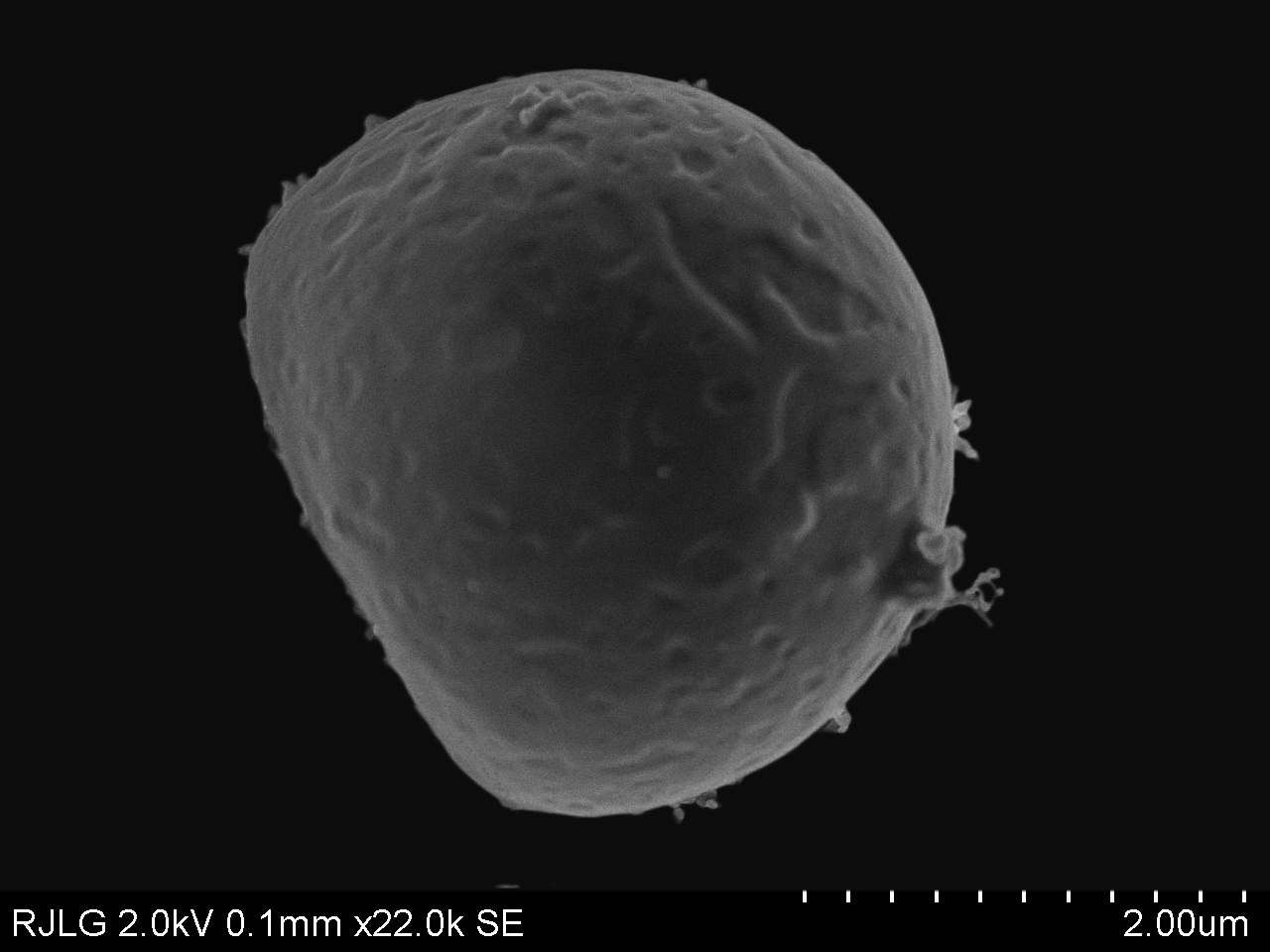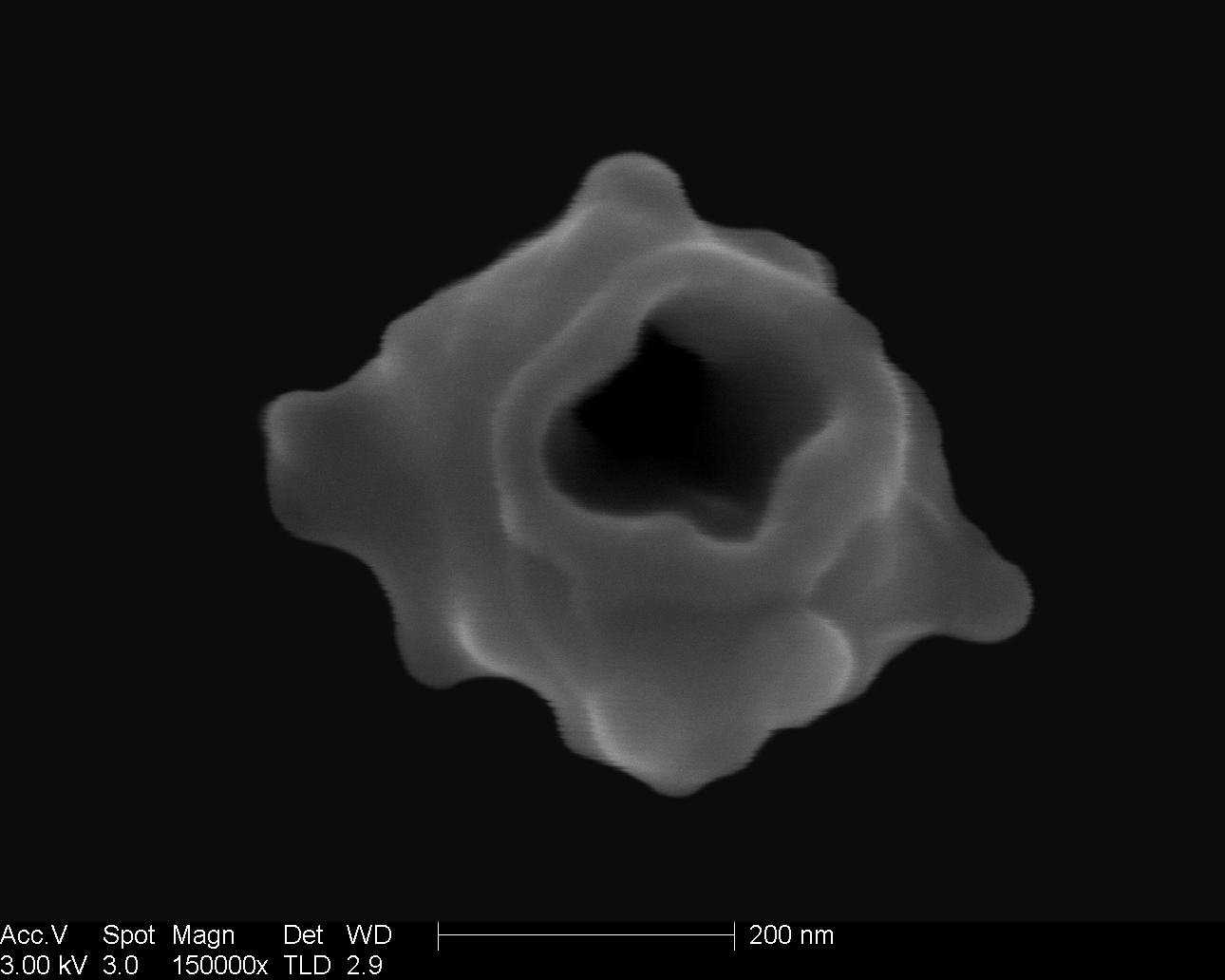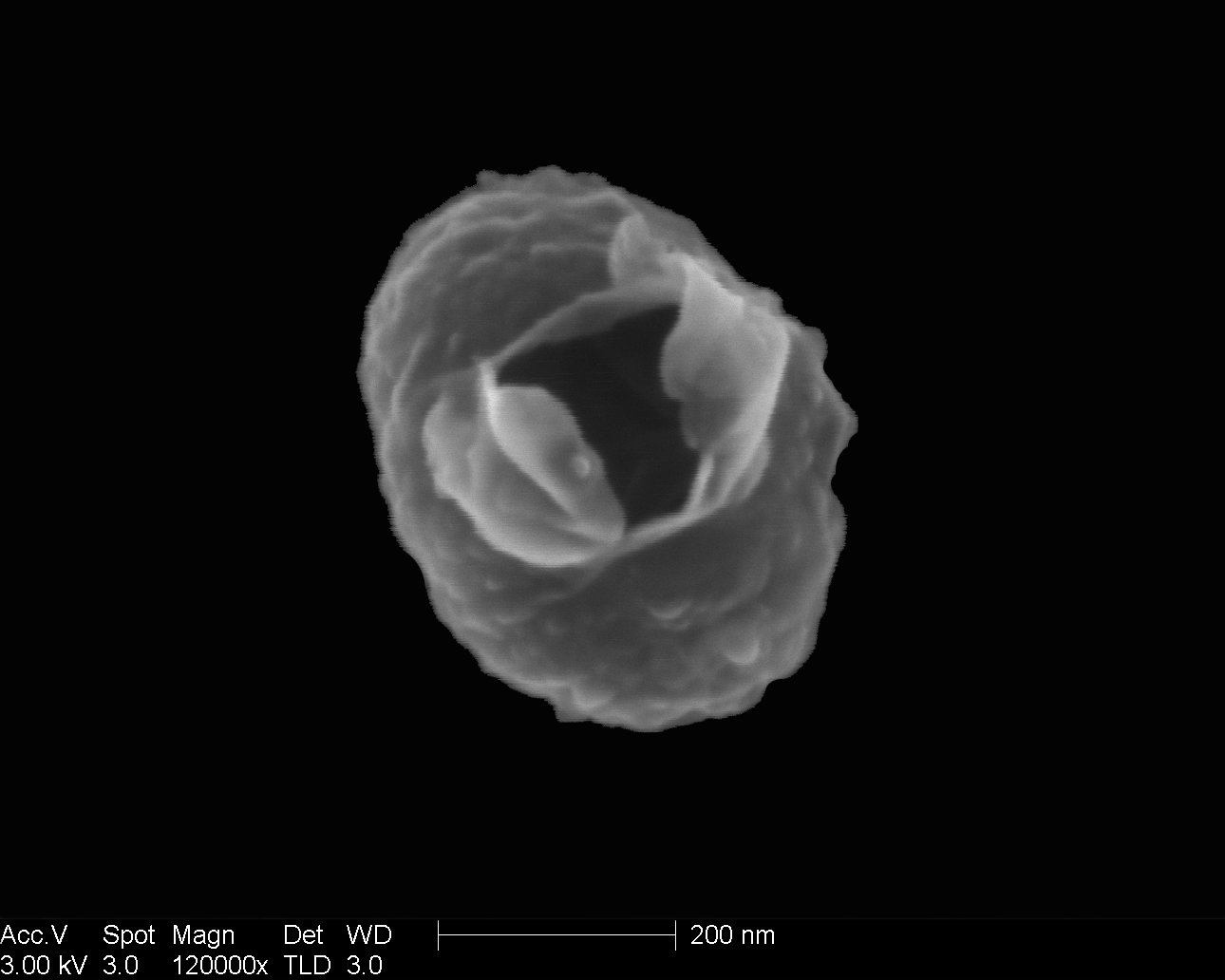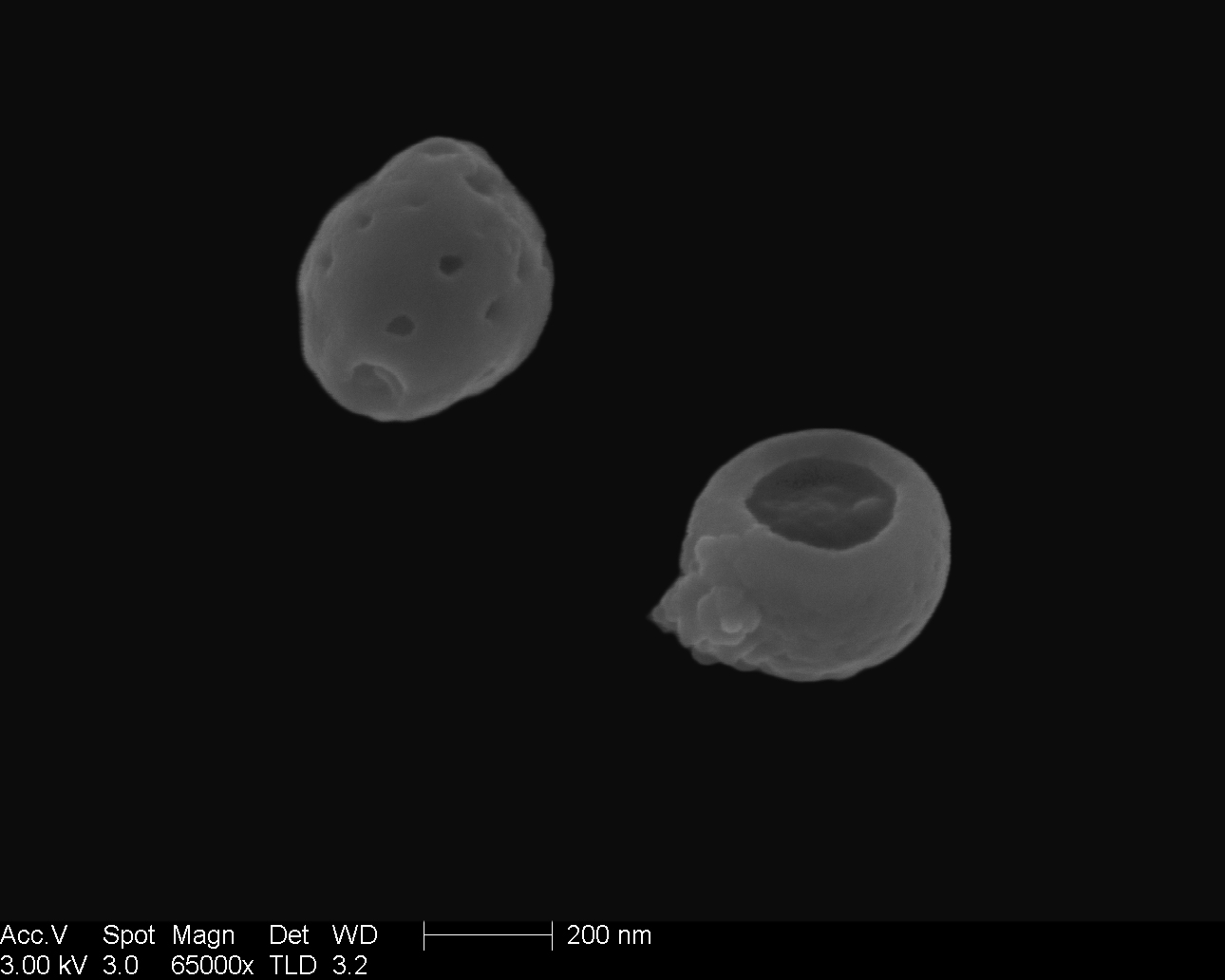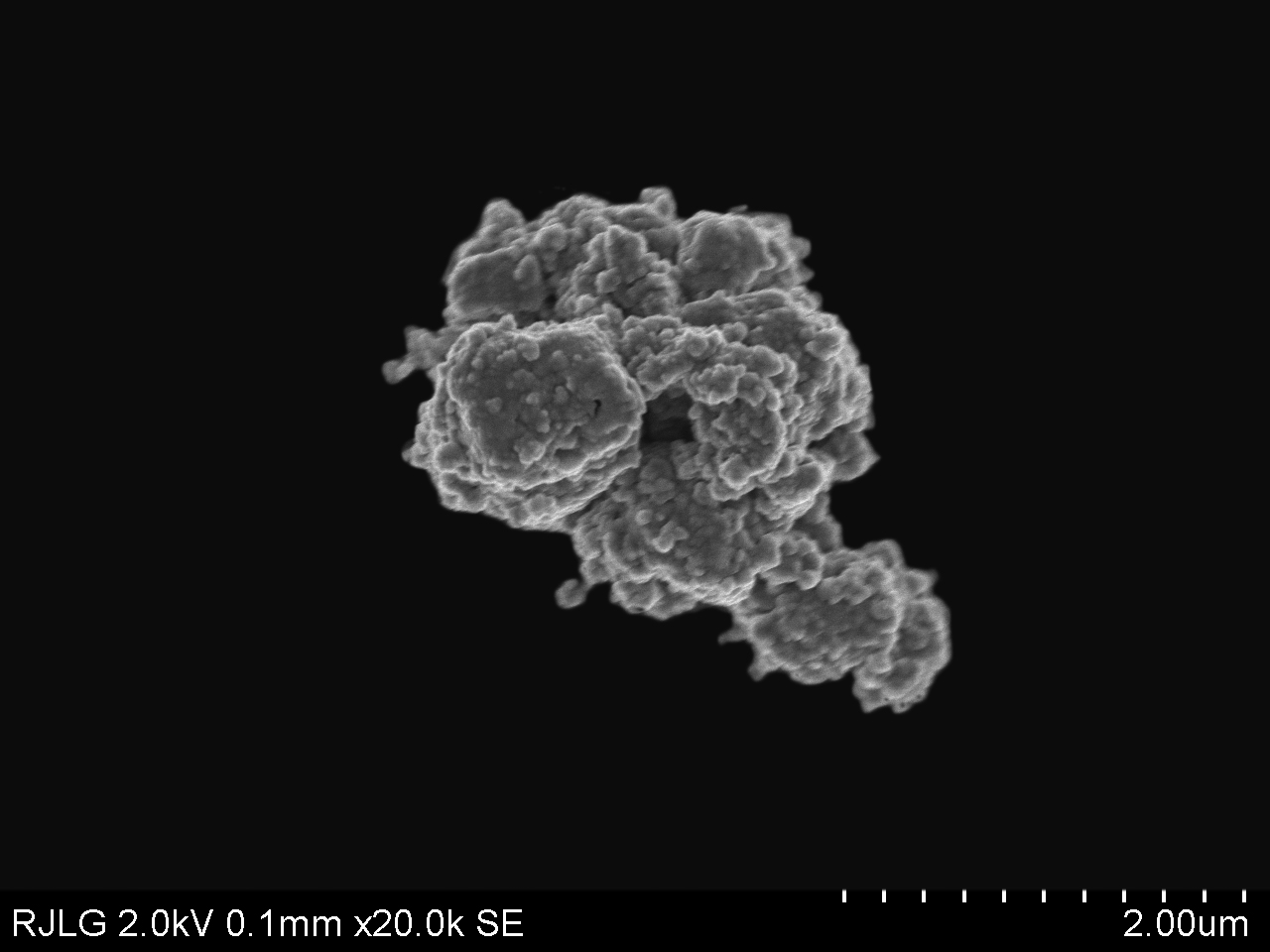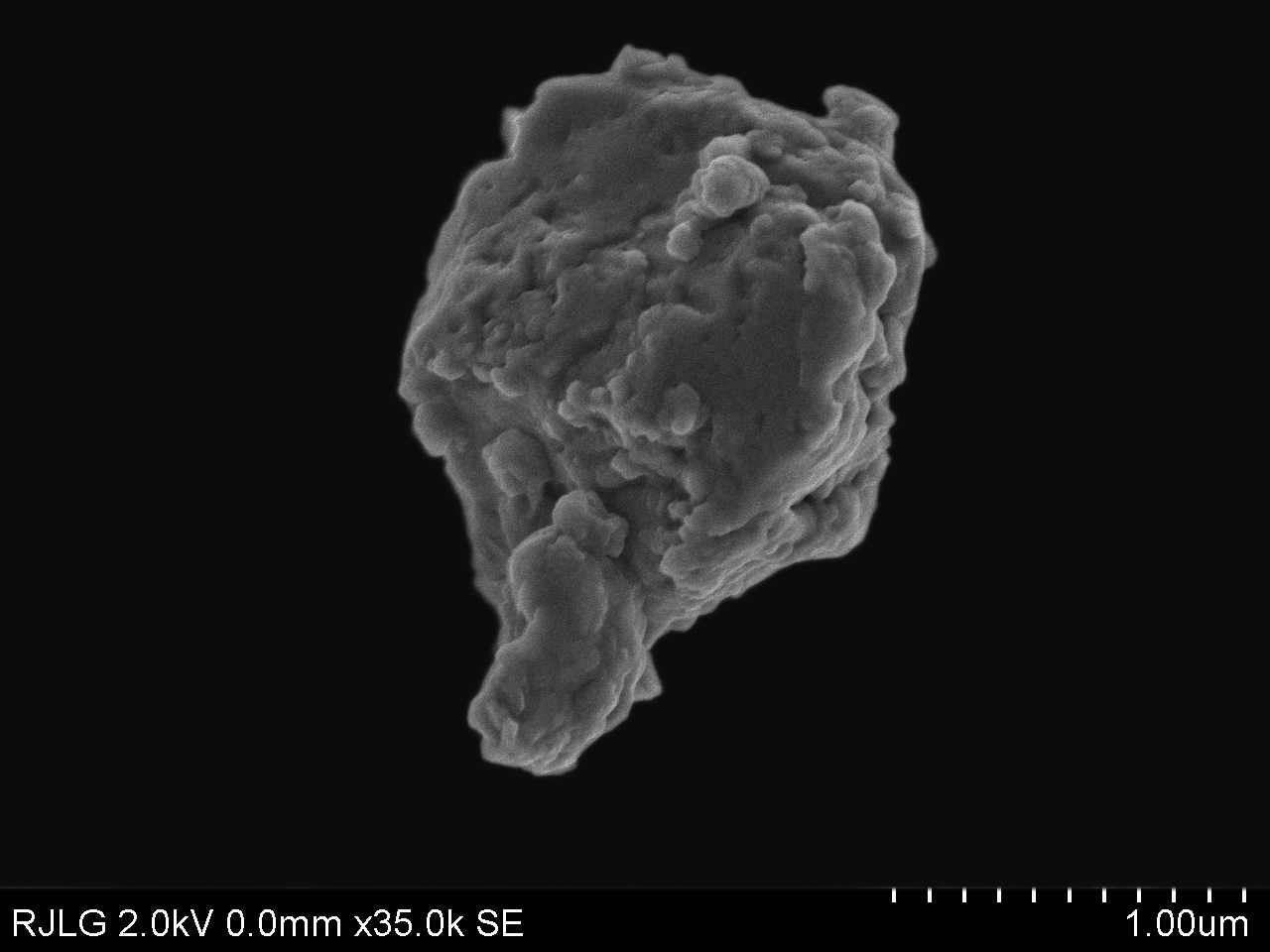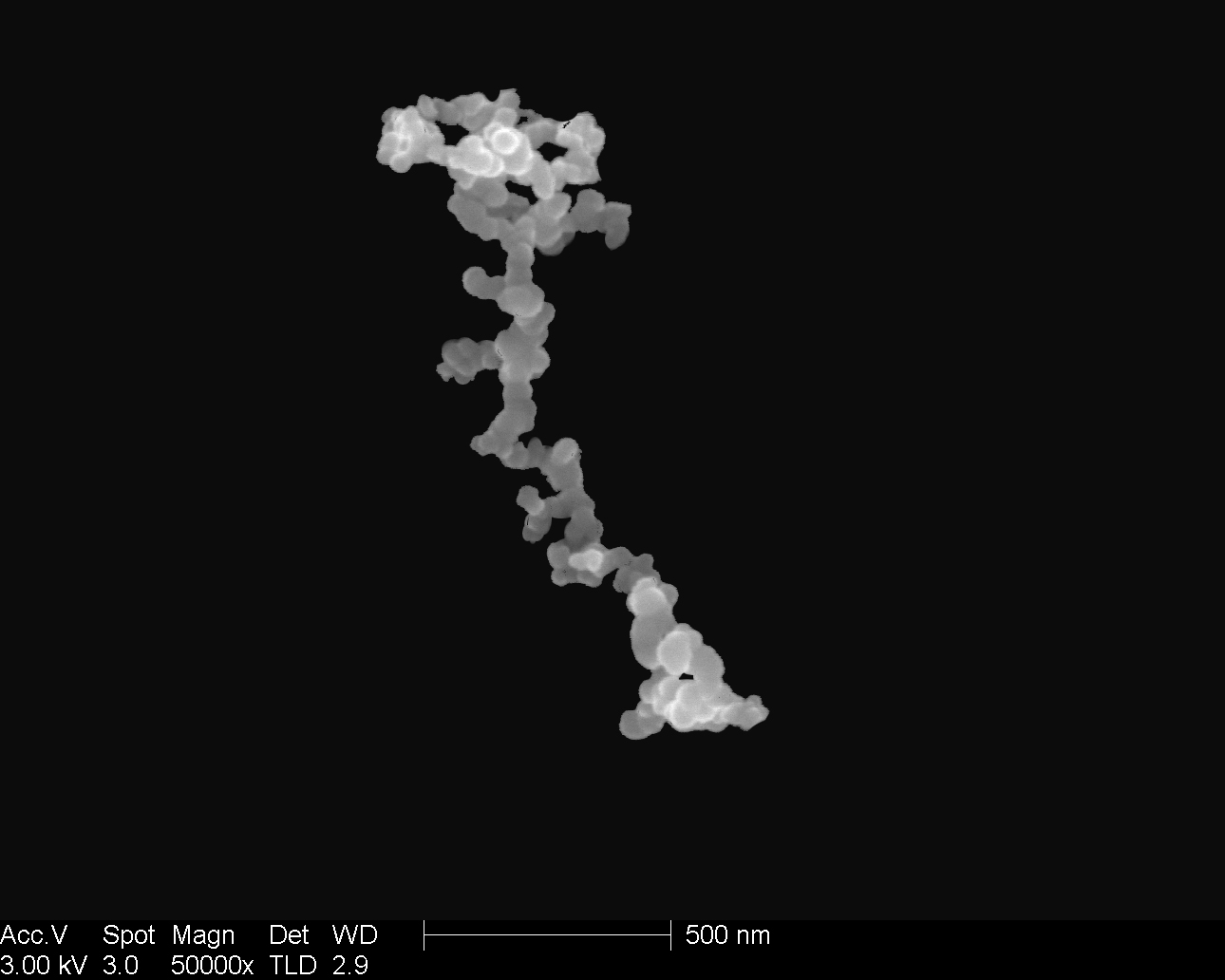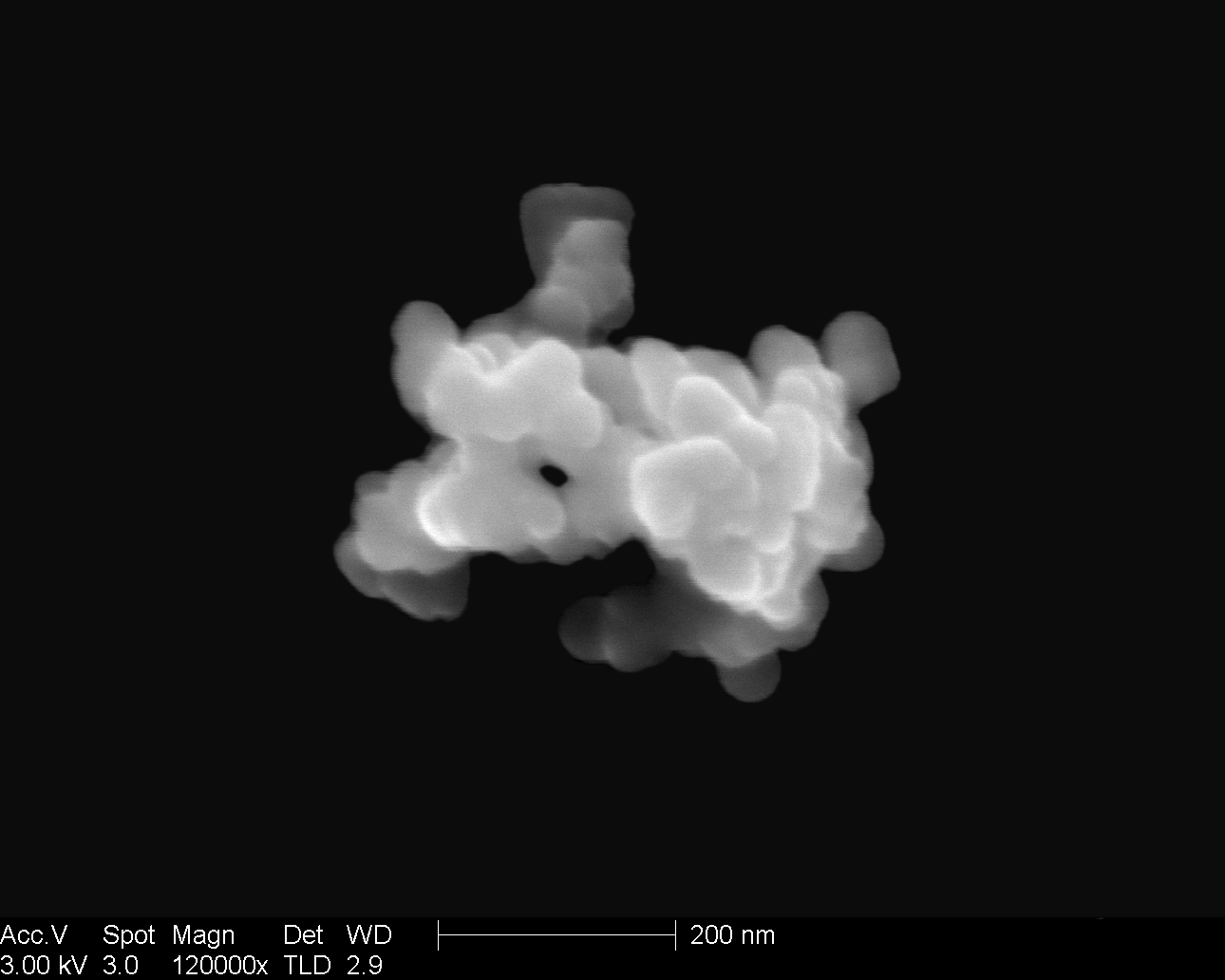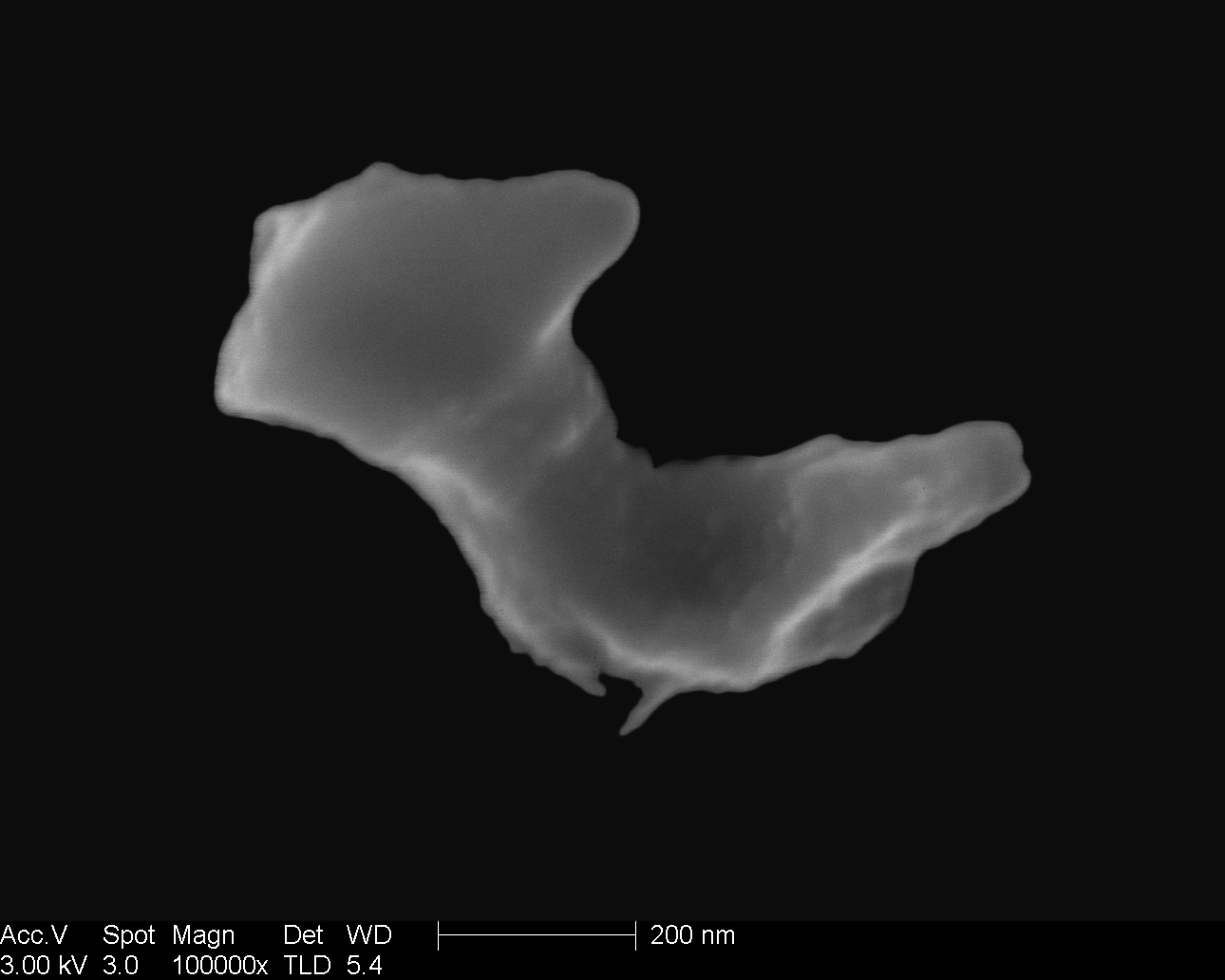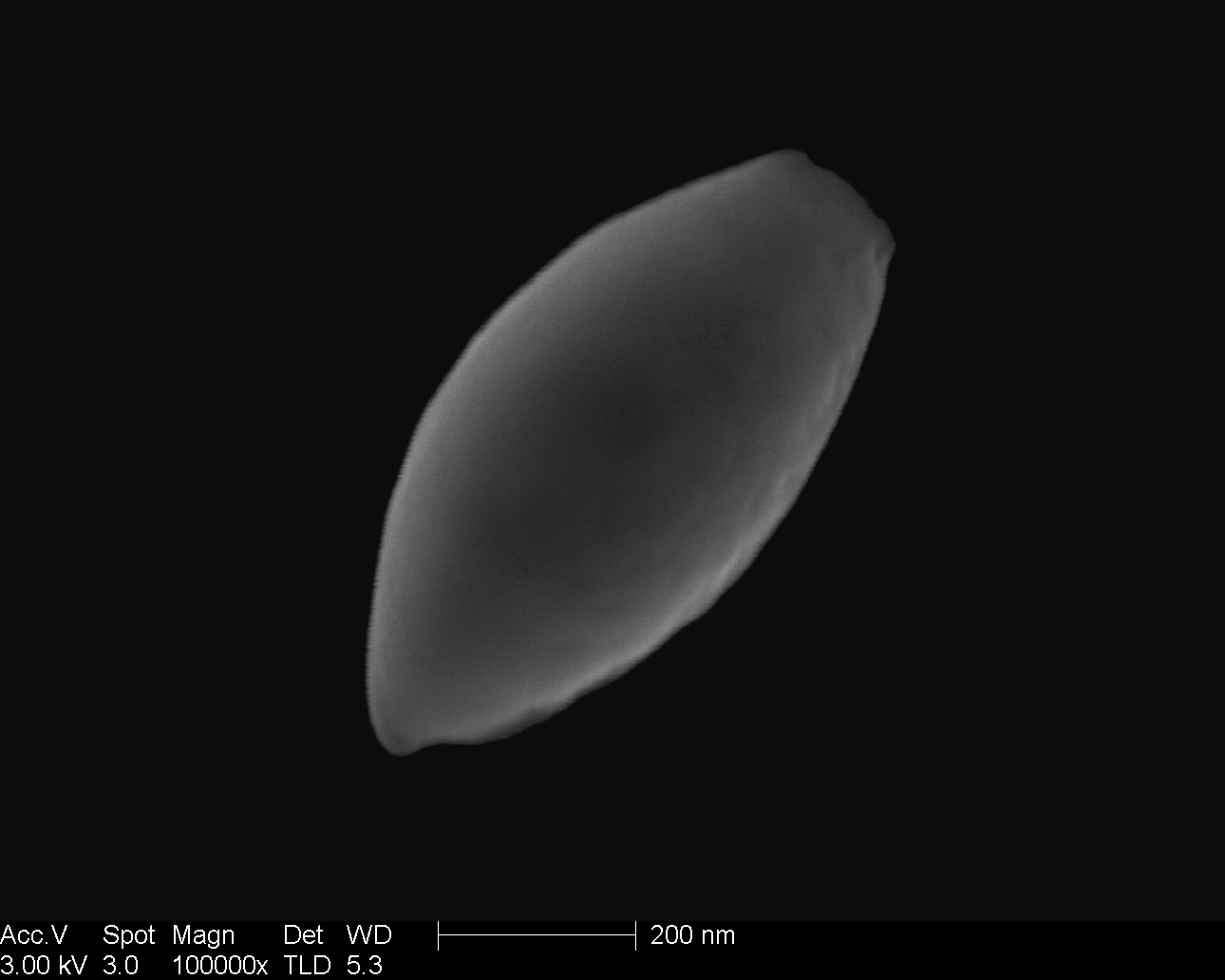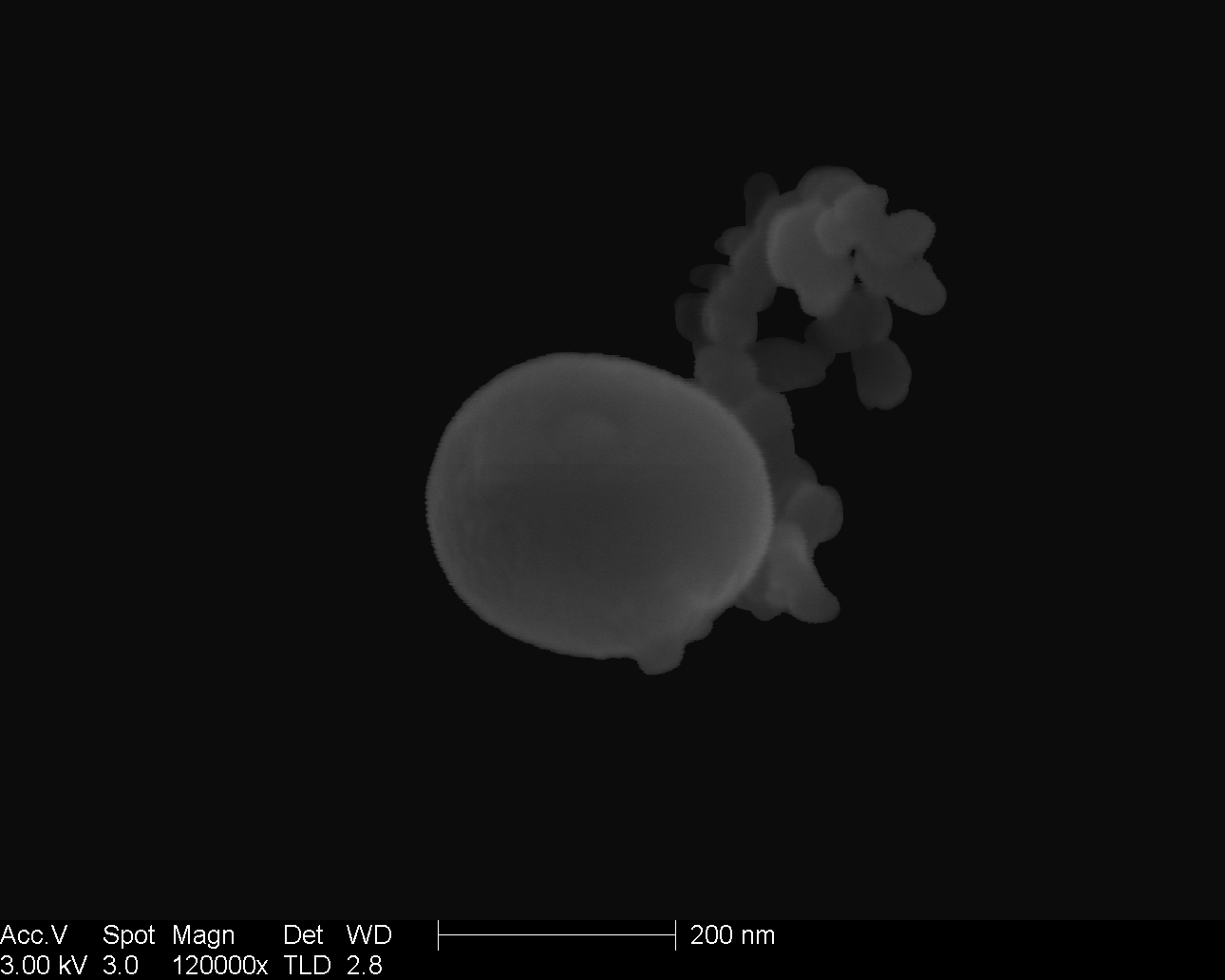Difference between revisions of "DAURE Microscopy"
(→Heavy Metal Oxides) |
(→Sulfates) |
||
| (27 intermediate revisions by the same user not shown) | |||
| Line 1: | Line 1: | ||
| − | This page | + | This page contains electron microscopy images acquired by Esther Coz of CIEMAT/IDAEA-CSIC at RJ Lee Group, Inc. (Monroeville PA, USA). |
| + | |||
| + | PM2.5 samples were collected in polycarbonate filters during the DAURE-2009 winter campaign. 12 different samples were taken at different times of the day (morning, mid-day, afternoon/evening and night). Time interval in samplings varied with PM2.5 concentration level at time of collection to avoid filter saturation. | ||
| + | |||
| + | The images presented below have been acquired with two different high resolution Scanning Electron Microscopes (FEI Sirion400 and Hitachi S5500). Background has been automatically substracted from images to enhance the morphology, but no post processing has been applied on the particles after acquisition. The different relative content of each of the groups (and subgroups) presented below has been quantified in each sample and its variations at different times of the day. More than 15,000 particles have been analyzed with a fully automated SEM (PSEM 500) and the FEI Sirion400. Size, morphological descriptors, and elemental composition of each of the individual particles have been stored. These data are still under review/analysis. Any commentaries, suggestions or corrections (if any mistake is found) are welcome. Please, email esther.coz@ciemat.es. | ||
| + | |||
| + | DAURE participants are allowed to use the pictures for meetings and presentations with proper acknowledgment. Please, contact Esther Coz in case of publishing to check the image has not been already used. | ||
| − | |||
== '''Images from the BCN site''' == | == '''Images from the BCN site''' == | ||
| − | + | <br> | |
=== Primary Biogenic Organic Particles === | === Primary Biogenic Organic Particles === | ||
| Line 12: | Line 17: | ||
|-style="height:140px" | |-style="height:140px" | ||
| − | | align="center" bgcolor="lightgrey"| [[image:BCN01-16 Spore.jpg|450px]] || '''Particle BCN-1''' <br>Fungi spore <br> Size = 3.3 µm <br> ''Composition:'' Major components: C, O; Minor components: S, Cl, Ca <br> | + | | align="center" bgcolor="lightgrey"| [[image:BCN01-16 Spore.jpg|450px]] || '''Particle BCN-1''' <br>Subgroup: Fungi spore <br> Sampling time: 02/25/09, 7- 9 pm <br>Size = 3.3 µm <br> ''Composition:'' Major components: C, O; Minor components: S, Cl, Ca <br> |
---- | ---- | ||
Notes: <br> Hiliferous appendix on the lower right, smooth ornament.<br> | Notes: <br> Hiliferous appendix on the lower right, smooth ornament.<br> | ||
|-style="height:140px" | |-style="height:140px" | ||
| − | | align="center" bgcolor="lightgrey"| [[image:FEI BCN012 1.jpg|450px]] || '''Particle BCN-2''' <br>Non classified <br> Size = 410 nm <br> ''Composition:'' Major components: C, O; Minor components: S, Cl <br> | + | | align="center" bgcolor="lightgrey"| [[image:FEI BCN012 1.jpg|450px]] || '''Particle BCN-2''' <br>Subgroup: Non classified <br> Sampling time: 02/28/09, 5.30-7.10 pm <br> Size = 410 nm <br> ''Composition:'' Major components: C, O; Minor components: S, Cl <br> |
---- | ---- | ||
Notes: <br> Morphology with circular aperture and ornament that reminds a fungi spore.<br> | Notes: <br> Morphology with circular aperture and ornament that reminds a fungi spore.<br> | ||
|-style="height:140px" | |-style="height:140px" | ||
| − | | align="center" bgcolor="lightgrey"| [[image: | + | | align="center" bgcolor="lightgrey"| [[image:BCN05_15_detritus.jpg|450px]] || '''Particle BCN-3''' <br>Subgroup: Vegetative detritus <br> Sampling time: 02/26/09, 7.40-8.20 pm <br> Size = 440 nm <br> ''Composition:'' Major components: C, O; Minor components: Al, Si (not always) <br> |
---- | ---- | ||
Notes: <br> The morphology reminds a vegetative tissue in which some volatile material was initially entrapped (see the open cut).<br> | Notes: <br> The morphology reminds a vegetative tissue in which some volatile material was initially entrapped (see the open cut).<br> | ||
|-style="height:140px" | |-style="height:140px" | ||
| − | | align="center" bgcolor="lightgrey"| [[image:FEI BCN01 18.jpg|450px]] || '''Particles BCN-4 & BCN-5''' <br>Fungi | + | | align="center" bgcolor="lightgrey"| [[image:FEI BCN01 18.jpg|450px]] || '''Particles BCN-4 & BCN-5''' <br>Subgroup: Fungi spore (possible) <br> ''Sampling time:'' 02/25/09, 7-9 pm <br> Size = 420 nm <br> ''Composition:'' Major components: C, O; Minor components: S, Si, Cl, Na, K <br> |
---- | ---- | ||
Notes: <br> Different morphologies of possible fungi spores with similar size and elemental composition. The one on the lower right has golf ball texture and seems to have volatile contain. Both of them are very abundant in the samples and frequently found mixed with soot agglomerates. | Notes: <br> Different morphologies of possible fungi spores with similar size and elemental composition. The one on the lower right has golf ball texture and seems to have volatile contain. Both of them are very abundant in the samples and frequently found mixed with soot agglomerates. | ||
|} | |} | ||
| + | <br> | ||
=== Heavy Metal Oxides === | === Heavy Metal Oxides === | ||
| Line 40: | Line 46: | ||
|-style="height:140px" | |-style="height:140px" | ||
| − | | align="center" bgcolor="lightgrey"| [[image:BCN01-33 Iron oxide.jpg|450px]] || '''Particle BCN-6''' <br>Iron oxide <br> Size = 1.9 µm <br> ''Composition:'' Major components: Fe2O3; Minor components: Si, S, Ti, Mg, Cl, Na <br> | + | | align="center" bgcolor="lightgrey"| [[image:BCN01-33 Iron oxide.jpg|450px]] || '''Particle BCN-6''' <br>Subgroup: Iron oxide <br> Sampling time: 02/25/09, 7-9 pm <br> Size = 1.9 µm <br> ''Composition:'' Major components: Fe2O3; Minor components: Si, S, Ti, Mg, Cl, Na <br> |
---- | ---- | ||
Notes: <br> Agglomerate structure and associated minor elements typical from vehicle emissions.<br> | Notes: <br> Agglomerate structure and associated minor elements typical from vehicle emissions.<br> | ||
|-style="height:140px" | |-style="height:140px" | ||
| − | | align="center" bgcolor="lightgrey"| [[image:File03_FE-Zn_Oxide.jpg|450px]] || '''Particle BCN-7''' <br>Iron-zinc oxide <br> Size = 1 µm<br> ''Composition:'' Fe2O4Zn; Minor components: Mn, Cr, Ca, Mg, S, Si, Al <br> | + | | align="center" bgcolor="lightgrey"| [[image:File03_FE-Zn_Oxide.jpg|450px]] || '''Particle BCN-7''' <br>Subgroup: Iron-zinc oxide <br> Sampling time: 02/26/09, 11-12 am <br> Size = 1 µm<br> ''Composition:'' Fe2O4Zn; Minor components: Mn, Cr, Ca, Mg, S, Si, Al <br> |
---- | ---- | ||
Notes: <br> Spherical morphology frequently associated to industrial combustion processes.<br> | Notes: <br> Spherical morphology frequently associated to industrial combustion processes.<br> | ||
|-style="height:140px" | |-style="height:140px" | ||
| − | | align="center" bgcolor="lightgrey"| [[image:File07 Iron oxide.jpg|450px]] || '''Particle BCN-8''' <br>Iron oxide <br> Size = 3 µm<br> ''Composition:'' Fe2O3; Minor components: Si, S, Cu, Cl, Mg, Al, Ca <br> | + | | align="center" bgcolor="lightgrey"| [[image:File07 Iron oxide.jpg|450px]] || '''Particle BCN-8''' <br>Subgroup: Iron oxide <br> Sampling time: 02/25/09, 7-9 pm <br> Size = 3 µm<br> ''Composition:'' Fe2O3; Minor components: Si, S, Cu, Cl, Mg, Al, Ca <br> |
---- | ---- | ||
Notes: <br> Associated minor elements indicate possible anthropogenic origin.<br> | Notes: <br> Associated minor elements indicate possible anthropogenic origin.<br> | ||
|} | |} | ||
| + | |||
| + | <br> | ||
=== Mineral Particles === | === Mineral Particles === | ||
| Line 62: | Line 70: | ||
|-style="height:140px" | |-style="height:140px" | ||
| − | | align="center" bgcolor="lightgrey"| [[image:FEI BCN013 1.jpg|450px]] || '''Particle BCN-9''' <br>Spherical AluminoSilicate (SAS particle) <br> Size = 800 nm <br> ''Composition:'' SiO2, Al2O3; Minor components: Ca, S, Na, Fe <br> | + | | align="center" bgcolor="lightgrey"| [[image:FEI BCN013 1.jpg|450px]] || '''Particle BCN-9''' <br>Subgroup: Spherical AluminoSilicate (SAS particle) <br> Sampling time: 02/28/09, 8.45 - 9.25 pm <br> Size = 800 nm <br> ''Composition:'' SiO2, Al2O3; Minor components: Ca, S, Na, Fe <br> |
---- | ---- | ||
Notes: <br> Spherical aluminosilicate related to coal fired power plant emissions. Also denoted as fly-ash.<br>Frequently found as single particles (not agglomerated) with a wide size range from several nanometers to several micrometers. <br> | Notes: <br> Spherical aluminosilicate related to coal fired power plant emissions. Also denoted as fly-ash.<br>Frequently found as single particles (not agglomerated) with a wide size range from several nanometers to several micrometers. <br> | ||
|-style="height:140px" | |-style="height:140px" | ||
| − | | align="center" bgcolor="lightgrey"| [[image:BCN01-47 calcite.jpg|450px]] || '''Particle BCN-10''' <br>Calcium carbonate (calcite) <br> Size = 1.6 µm <br> ''Composition:'' CaCO3 <br> | + | | align="center" bgcolor="lightgrey"| [[image:BCN01-47 calcite.jpg|450px]] || '''Particle BCN-10''' <br>Subgroup: Calcium carbonate (calcite) <br> Sampling time: 02/25/09, 7-9 pm <br> Size = 1.6 µm <br> ''Composition:'' CaCO3 <br> |
|-style="height:140px" | |-style="height:140px" | ||
| − | | align="center" bgcolor="lightgrey"| [[image:BCN01-37-38 quartz.jpg|450px]] || '''Particle BCN-11''' <br>Quartz <br> Size = 1.7 µm <br> ''Composition:'' SiO2 <br> | + | | align="center" bgcolor="lightgrey"| [[image:BCN01-37-38 quartz.jpg|450px]] || '''Particle BCN-11''' <br>Subgroup: Quartz <br> Sampling time: 02/25/09, 7-9 pm <br> Size = 1.7 µm <br> ''Composition:'' SiO2 <br> |
---- | ---- | ||
Notes: <br> Image taken at 2 kV (left) and 15 kV (right) allows to compare how different particles may look if changed any operation value. <br> | Notes: <br> Image taken at 2 kV (left) and 15 kV (right) allows to compare how different particles may look if changed any operation value. <br> | ||
|-style="height:140px" | |-style="height:140px" | ||
| − | | align="center" bgcolor="lightgrey"| [[image:BCN01-39 Gypsum.jpg|450px]] || '''Particle BCN-12''' <br>Calcium sulfate (gypsum) <br> Size = 1.1 µm <br> ''Composition:'' CaSO4-2(H2O) <br> | + | | align="center" bgcolor="lightgrey"| [[image:BCN01-39 Gypsum.jpg|450px]] || '''Particle BCN-12''' <br>Subgroup: Calcium sulfate (gypsum) <br> Sampling time: 02/25/09, 7-9 pm <br> Size = 1.1 µm <br> ''Composition:'' CaSO4-2(H2O) <br> |
---- | ---- | ||
Notes: <br> Tabular crystal of calcium sulfate(probably gypsum).<br> | Notes: <br> Tabular crystal of calcium sulfate(probably gypsum).<br> | ||
|} | |} | ||
| + | |||
| + | <br> | ||
=== Soot-like Agglomerates === | === Soot-like Agglomerates === | ||
| + | Soot-like is the most abundant particle structure for all the samples independently of the day and time of sampling. Larger percentage of "fresh" type (BCN-13) are found on samples associated to traffic peak hours, when the opposite trend (larger abundance of "aged" type, BCN-14) occurs for samples collected during the rest of the sampling times. These types of structures are generally linked to diesel emissions. However, other type of aerosols, such as certain biogenic organic compounds, can be also linked to this type of structures. | ||
{| border="0" cellpadding="3" | {| border="0" cellpadding="3" | ||
|-style="height:140px" | |-style="height:140px" | ||
| − | | align="center" bgcolor="lightgrey"| [[image:FEI BCN04 18 soot.jpg|450px]] || '''Particle BCN-13''' <br>Fresh soot agglomerate <br> Size = 290 nm <br> ''Composition:'' Major components: C, O; Minor components: S, Si, Na <br> | + | | align="center" bgcolor="lightgrey"| [[image:FEI BCN04 18 soot.jpg|450px]] || '''Particle BCN-13''' <br>Subgroup: Fresh soot-like agglomerate <br> Sampling time: 02/26/09, 3-4 pm <br> Size = 290 nm <br> ''Composition:'' Major components: C, O; Minor components: S, Si, Na <br> |
---- | ---- | ||
Notes: <br> Chain-like structure of agglomerates generally indicates the aerosol is fresh. Size of the primitive particles ranges from 40-60 nm. The agglomerate is coated with a sulfate (possible organic/sulfate mixture) layer. <br> | Notes: <br> Chain-like structure of agglomerates generally indicates the aerosol is fresh. Size of the primitive particles ranges from 40-60 nm. The agglomerate is coated with a sulfate (possible organic/sulfate mixture) layer. <br> | ||
|-style="height:140px" | |-style="height:140px" | ||
| − | | align="center" bgcolor="lightgrey"| [[image:FEI BCN06 Soot 5.jpg|450px]] || '''Particle BCN-14''' <br>Aged soot agglomerate <br> Size = 390 nm <br> ''Composition:'' Major components: C, O; Minor components: S, Si, Na <br> | + | | align="center" bgcolor="lightgrey"| [[image:FEI BCN06 Soot 5.jpg|450px]] || '''Particle BCN-14''' <br>Subgroup: Aged soot-like agglomerate <br> Sampling time: 02/26/09, 7.30-8 am <br> Size = 390 nm <br> ''Composition:'' Major components: C, O; Minor components: S, Si, Na <br> |
---- | ---- | ||
Notes: <br> Sponge structure indicates aerosol aging. The coating thickness in this type of structues strongly varies with the time of the day due to the condensation of organics on the surface. <br> | Notes: <br> Sponge structure indicates aerosol aging. The coating thickness in this type of structues strongly varies with the time of the day due to the condensation of organics on the surface. <br> | ||
|} | |} | ||
| + | |||
| + | <br> | ||
=== Other Carbonaceous Particles === | === Other Carbonaceous Particles === | ||
| + | |||
| + | Examples of some other carbonaceous particles (probably organic aerosols) found in the samples are presented next. | ||
| + | |||
| + | {| border="0" cellpadding="3" | ||
| + | |||
| + | |-style="height:140px" | ||
| + | | align="center" bgcolor="lightgrey"| [[image:BCN01-14_organic.jpg|450px]] || '''Particle BCN-15''' <br>Subgroup: Other carbonaceous particles <br> Sampling time: 02/25/09, 7-9 pm <br> Size = 350 nm <br> ''Composition:'' Major components: C, O <br> | ||
| + | |||
| + | |||
| + | |-style="height:140px" | ||
| + | | align="center" bgcolor="lightgrey"| [[image:FEI_BCN03_1_copia.jpg|450px]] || '''Particle BCN-16''' <br>Subgroup: Other carbonaceous particles <br> Sampling time: 02/26/09, 11-12 am <br> Size = 530 nm <br> ''Composition:'' Major components: C, O <br> | ||
| + | |||
| + | |} | ||
| + | |||
| + | <br> | ||
=== Sulfates === | === Sulfates === | ||
| + | {| border="0" cellpadding="3" | ||
| + | |||
| + | |-style="height:140px" | ||
| + | | align="center" bgcolor="lightgrey"| [[image:BCN03_18_Sulfate.jpg|450px]] || '''Particle BCN-17''' <br>Subgroup: Sulfate <br> Sampling time: 02/26/09, 11-12 am <br> Size = 510 nm <br> ''Composition:'' Major components: S, O <br> | ||
| + | ---- | ||
| + | Notes: <br>Probably ammonium sulfate or bisulfate <br> | ||
| + | |||
| + | |-style="height:140px" | ||
| + | | align="center" bgcolor="lightgrey"| [[image:BCN02_1_Sulfate.jpg|450px]] || '''Particle BCN-18''' <br>Subgroup: Sulfate <br> Sampling time: 02/26/09, 7-7.50 am <br> Size = 215 nm (360 nm, sulfate + soot-like)<br> ''Composition:'' Major components: S, O <br> | ||
| + | ---- | ||
| + | Notes: <br> Bubble shaped ammonium sulfate linked to a soot-like structrure typical from diesel emissions. <br> | ||
| + | |||
| + | |} | ||
== '''Images from the MSY site''' == | == '''Images from the MSY site''' == | ||
| Line 108: | Line 149: | ||
Upcoming... | Upcoming... | ||
| + | |||
| + | |||
| + | == '''Acknowledgements''' == | ||
| + | |||
| + | The electron microscopy images contained in this page have been acquired by Esther Coz of CIEMAT/IDAEA-CSIC at RJ Lee Group, Inc. facilities. Special aknowledge is given to RJ Lee Group (Monroeville PA, USA) for kindly allowing the use of their microscopies for this study. | ||
| + | |||
| + | The work has been partially funded by the following projects of the Spanish Ministry of Science and Innovation: <br> | ||
| + | - GRACCIE Project, CSD2007:0067 <br> | ||
| + | - Acción Complementaria CGL2008- 02817-E/CLI <br> | ||
| + | - Project CGL2007-64117/CLI <br> | ||
Latest revision as of 12:58, 27 April 2009
This page contains electron microscopy images acquired by Esther Coz of CIEMAT/IDAEA-CSIC at RJ Lee Group, Inc. (Monroeville PA, USA).
PM2.5 samples were collected in polycarbonate filters during the DAURE-2009 winter campaign. 12 different samples were taken at different times of the day (morning, mid-day, afternoon/evening and night). Time interval in samplings varied with PM2.5 concentration level at time of collection to avoid filter saturation.
The images presented below have been acquired with two different high resolution Scanning Electron Microscopes (FEI Sirion400 and Hitachi S5500). Background has been automatically substracted from images to enhance the morphology, but no post processing has been applied on the particles after acquisition. The different relative content of each of the groups (and subgroups) presented below has been quantified in each sample and its variations at different times of the day. More than 15,000 particles have been analyzed with a fully automated SEM (PSEM 500) and the FEI Sirion400. Size, morphological descriptors, and elemental composition of each of the individual particles have been stored. These data are still under review/analysis. Any commentaries, suggestions or corrections (if any mistake is found) are welcome. Please, email esther.coz@ciemat.es.
DAURE participants are allowed to use the pictures for meetings and presentations with proper acknowledgment. Please, contact Esther Coz in case of publishing to check the image has not been already used.
Contents
Images from the BCN site
Primary Biogenic Organic Particles
Despite not being an important group in abundance, the microscopy analysis of PM2.5 samples from BCN site revealed a very rich diversity of this particle type. Several families of spores, vegetative and insect detritus and bacteria have been identified with sizes from 300 nm up to 4 µm. Some of them are frequently mixed with other anthropogenic aerosols.
Heavy Metal Oxides
Frequently found in the PM2.5 samples collected during traffic peak hours with sizes from 800 nm up to 5 µm. Some of them are frequently mixed with mineral particles. The most abundant are iron oxides (frequently linked to minor contents of titanium and zinc).
Mineral Particles
Soot-like Agglomerates
Soot-like is the most abundant particle structure for all the samples independently of the day and time of sampling. Larger percentage of "fresh" type (BCN-13) are found on samples associated to traffic peak hours, when the opposite trend (larger abundance of "aged" type, BCN-14) occurs for samples collected during the rest of the sampling times. These types of structures are generally linked to diesel emissions. However, other type of aerosols, such as certain biogenic organic compounds, can be also linked to this type of structures.
Other Carbonaceous Particles
Examples of some other carbonaceous particles (probably organic aerosols) found in the samples are presented next.
Sulfates
Images from the MSY site
Upcoming...
Acknowledgements
The electron microscopy images contained in this page have been acquired by Esther Coz of CIEMAT/IDAEA-CSIC at RJ Lee Group, Inc. facilities. Special aknowledge is given to RJ Lee Group (Monroeville PA, USA) for kindly allowing the use of their microscopies for this study.
The work has been partially funded by the following projects of the Spanish Ministry of Science and Innovation:
- GRACCIE Project, CSD2007:0067
- Acción Complementaria CGL2008- 02817-E/CLI
- Project CGL2007-64117/CLI
